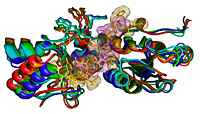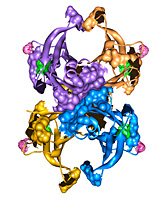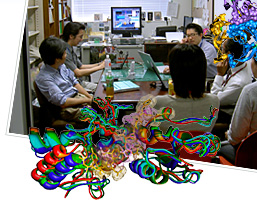Potential clients include small- and medium-sized pharmaceutical and biotech companies wishing to utilize specialized, limited-time contract research and/or consulting relating to protein structure and dynamics.
RECONESIS can provide advice and/or actual computational biology/computational chemistry research in this area, for a specific period of time, and with full confidentiality. RECONESIS aims to provide research support equivalent to what could be obtained from a collaboration with an academic basic science research group. However, such collaborations with academia often are not possible without sharing intellectual property rights. RECONESIS will perform research services and consulting for a defined fee, with no claim on intellectual property.
1. Peptide design
Conformational analysis using designed constrained peptides. Conformationally constrained peptides can be used as probes for receptor-bound conformations of peptide ligands. This can aid in further optimization of such peptides as a basis for biologics (protein-based therapeutics) or to create peptide structural templates for non-peptide drug candidates.
2. Computational chemistry / biology
Practical applications of molecular dynamics simulations
- Enhanced understanding of ligand binding phenomena, protein-protein interactions, protein stability, and protein aggregation. In particular, entropic and allosteric effects can be predicted in some cases. This could be particularly useful in understanding the protein-protein interactions involved in the activity of biologics such as vaccines and antibodies.
- New approaches to ligand design, such as designing allosteric inhibitors or activators of proteins. These approaches can be suggested and planned for application by your company or another lab, or actually carried out by RECONESIS as contract research.
- New approaches to protein engineering, using amino acid substitutions to induce and/or alter allosteric pathways.
- Prediction of the effects of disease-related mutations, to suggest therapeutic approaches that counteract these effects, particularly using allosteric effects of artificial mutations to predict binding sites for allosterically-acting drugs.
3. Other support
- Consulting, advice, and assistance in the setup and use of advanced molecular dynamics techniques in your group.
- Consulting, advice, and assistance in application of other protein modeling and computational biology techniques.
- Design of transforming growth factor-β mimics (receptor agonists and antagonists), as described in United States patents US 6,638,912 B2 and US 6,509,318 B1.
 Research
on cancer-inducing allosteric effects on protein-protein interactions
in the tumor suppressor BRCA1: Gough, C.A.; Gojobori, T.; and Imanishi,
T. "Cancer-related mutations in BRCA1-BRCT cause long-range structural
changes in protein-protein binding sites: a molecular dynamics study."
(2007). Proteins 66(1): 69-86.
Research
on cancer-inducing allosteric effects on protein-protein interactions
in the tumor suppressor BRCA1: Gough, C.A.; Gojobori, T.; and Imanishi,
T. "Cancer-related mutations in BRCA1-BRCT cause long-range structural
changes in protein-protein binding sites: a molecular dynamics study."
(2007). Proteins 66(1): 69-86. Research
on allosteric phenomena in transthyretin that destablize protein-protein
interactions via entropic effects. Presentation of this work available
on request; publication in preparation: Gough, C.A.; Gojobori, T.;
Imanishi, T. "Dynamic phenomena and amyloidogenicity in transthyretin:
a molecular dynamics study."
Research
on allosteric phenomena in transthyretin that destablize protein-protein
interactions via entropic effects. Presentation of this work available
on request; publication in preparation: Gough, C.A.; Gojobori, T.;
Imanishi, T. "Dynamic phenomena and amyloidogenicity in transthyretin:
a molecular dynamics study."- Performed an analysis of medical device clinical studies conducted by the United States Food and Drug Administration (FDA), in order to extract the essential factors used in FDA approval of such devices. This was performed to assist researchers at Tokyo Women's Medical University in their project to develop standards for approval of such devices by the Japanese government.



